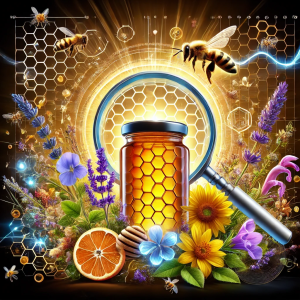
Unlocking the Secrets of UAE Honey: The Role of Local Flora in Quality, Flavor, and Sustainability
The botanical origin of honey plays a vital role in determining its quality, flavor, and medicinal properties, and this is especially true when examining honey produced in the unique environmental conditions of the UAE. Honey is made from the nectar collected by bees from various flowering plants, and the specific floral sources influence not only the taste but also the nutritional and therapeutic qualities of the honey. In the UAE, the distinct flora, such as the Sidr (Ziziphus spina-christi), Ghaf (Prosopis cineraria), and Acacia trees, along with desert wildflowers, provide nectar that gives locally-produced honey its unique character. These plants thrive in the arid climate, offering a rich variety of nectar for bees to collect. Understanding and identifying the botanical origins of honey is crucial for quality control, as honey from different plants has varying levels of antioxidants, vitamins, and antibacterial properties. For instance, Sidr honey is renowned for its medicinal qualities and is one of the most sought-after types in the UAE, praised for its rich taste and therapeutic properties.
Fujairah Research Centre (FRC) is spearheading efforts to enhance the understanding of the UAE's unique floral landscape and how it affects honey production. They are conducting extensive studies on the botanical origins of honey in Fujairah, mapping the various nectar sources that bees rely on within the region. By identifying the specific plants contributing to honey production, the FRC aims to create a comprehensive pollen library. This pollen library is invaluable for determining the floral sources of honey through pollen analysis, a process known as melissopalynology. Pollen grains found in honey reflect the types of flowers from which the nectar was collected, and by comparing these pollen grains with those in the pollen library, it is possible to accurately trace the botanical origin of the honey. The botanical origin of honey significantly affects its composition. For instance, honey derived from Ghaf trees has a slightly smoky flavor and a rich, amber hue, while Acacia honey is lighter in color and has a delicate, sweet taste. The variability in nectar sources not only impacts flavor but also the honey's texture, crystallization rate, and health benefits. Nectar from certain plants can result in honey with higher antimicrobial properties, while others might contribute to honey with greater antioxidant activity. The UAE's floral diversity offers a unique profile of honey types that can be studied and standardized for quality control, both domestically and internationally. FRC's research into the UAE flora is contributing to the establishment of strict standards for honey quality control in the UAE, ensuring that local honey can meet international standards. By developing a detailed pollen library specific to the region, the centre helps beekeepers and honey producers verify the authenticity and purity of their honey, particularly with high-value varieties like Sidr honey, which are often subject to adulteration. This research also aids in the standardization of UAE honey products, ensuring that consumers receive genuine honey that retains the medicinal and nutritional benefits associated with its botanical origin. In addition to aiding in honey standardization, the FRC's research into the botanical origins of honey supports sustainable beekeeping practices in the UAE. By identifying which plants are most beneficial for honey production, the FRC can provide guidance to beekeepers on planting and maintaining flora that support healthy bee populations and yield high-quality honey. This is particularly important in the UAE's desert environment, where water scarcity and extreme temperatures can limit the availability of flowering plants. Sustainable flora management ensures that bees have access to diverse nectar sources year-round, reducing the impact of environmental stressors on bee colonies and enhancing honey production. The combination of understanding nectar sources and using pollen profiling allows beekeepers to enhance honey quality by focusing on specific flora that contribute to desirable honey traits. For example, the UAE’s Sidr tree is not only culturally significant but also produces some of the most prized honey in the country. By identifying key nectar sources and their seasonal availability, beekeepers can optimize honey harvesting periods and improve the overall productivity and quality of their operations. Furthermore, the FRC’s work contributes to environmental conservation efforts by promoting the planting of native flora that support bee populations. In a region where urbanization and desertification pose challenges to natural habitats, efforts to preserve and propagate nectar-rich plants are crucial. The pollen library and botanical studies carried out by the FRC also provide important insights into how climate change may be affecting local plant species and, by extension, honey production. Understanding the impact of changing weather patterns on flowering plants and nectar availability allows for better long-term planning in the apiculture sector. In conclusion, the botanical origin of honey plays a pivotal role in defining its quality, flavor, and health benefits. The UAE’s unique flora, with its rich variety of nectar sources, provides a diverse range of honey products that are both nutritionally valuable and highly sought after. Through the dedicated research of the Fujairah Research Centre, a deeper understanding of the relationship between local plants and honey production is being developed, which is critical for honey quality control, standardization, and sustainability. The creation of a comprehensive pollen library not only aids in verifying the authenticity of UAE honey but also supports environmental conservation and sustainable beekeeping practices. With the ongoing efforts of the FRC and other environmental bodies, the UAE is positioned to become a leader in high-quality honey production, maintaining the purity and medicinal value of its honey in both local and global markets.
